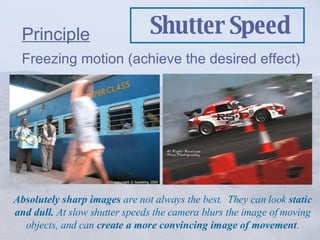Basic Photography Lesson
- 2. The 6 Things To Know Know your camera Hold the camera still The 2-second rule Take a few more Tell a “story” Capture the “mood”
- 3. C . E . L . L . C omposition E xposure L ens L ight
- 4. Composition Principle 1 Un-clutter the picture. Zoom in. A good photograph is a subject , a context , and nothing else . Remove any clutter that detracts from your message. Get closer -- zoom in -- and crop as tightly as possible
- 5. Composition Principle 2 Put subject off-centre / Rule of thirds The center of the frame is the weakest place -- it's static, dull, and gives no value to the context. The more you move the subject away from the center , the more relevance you give to the context unless it’s a reflection
- 6. Composition Principle 3 Use of frames, lines & diagonals Create impact by using frames and real or inferred lines that lead the viewer's eye into and around the picture
- 7. Composition Principle 4 Dramatic Perspective Create impact by photographing your subjects from unexpected angles. Imagine yourself as an electron spinning around the subject, which is the nucleus of an atom
- 8. Exposure Aperture Shutter speed ISO
- 9. Aperture : General Rules and tips A larger lens opening (f1.8-3.5) offers the following advantages: Allows you to shoot more often with just natural lighting helps to reduce harsh shadows and red-eye caused by flash. Allows more light to pass through, the camera will be able to choose a slightly higher shutter speed helps to reduce motion blur. Helps to reduce "depth-of-field“ (for effect).
- 10. Aperture Principle Affect depth of field (range of distance in focus) When shooting a landscape , as much of the photograph in sharp focus as possible (f11 to f22). In a portrait , shallower dof (f2.8-8) will isolate your subject from distracting backgrounds
- 11. Shutter speed : General Rules and tips To capture blur-free "action" photographs (e.g. Sports), you need to make sure the camera is using a high shutter speed, e.g.1/125th of a second or more. Less light gets through to the imager as shutter speed is increased, thus difficult to use higher shutter speeds in lower light situations . Alternatives: Allow more light to pass through the lens ( larger aperture setting ), the other is to increase the ISO
- 12. Shutter Speed Principle Freezing motion (achieve the desired effect) Absolutely sharp images are not always the best. They can look static and dull. At slow shutter speeds the camera blurs the image of moving objects, and can create a more convincing image of movement .
- 13. ISO: General Rules and tips ISO settings are often rated at 100, 200, 400, 800, 1600, and even 3200 on some models Use an ISO of 100 or 200 when taking photographs outside in sunny conditions. If the sky is overcast or it is evening time, or in a darkened room, then use an ISO within the range of 400 to 800 . Night time or in cases of low light you might need to set your digital camera ISO to 1600 . If not your photo will appear too dark, if at all.
- 14. ISO Setting Principle Set the lowest setting possible to avoid noise ISO measures the sensitivity of the image sensor . The lower the number the less sensitive your camera is to light and the finer the grain . ISO 100 ISO 3200
- 15. Lens Principle Wide Angle (35mm) or Telephoto (70mm) Wide-angle lenses allow more of a picture to be captured (need focal point ) while telephoto lenses tighten the scene and isolate the subject (but affect the depth of field & increase camera shake )
- 16. Light Principle 1 Avoid using flash, even for night shots The indiscriminate blast of flash destroys the intimate mood of existing light
- 17. Light Principle 2 Side Lighting instead of front or overhead (noon-time) lighting The use of frontal flash lighting tends to flatten faces. Use side lighting as much as possible, even moving your subject, if necessary, next to a window.
- 18. Light Principle 3 Use fill-in flash, for backlit situations or overhead sun. Overhead sun creates dark eye sockets and unattractive shadows , which can be reduced by using a flash. Use fill-in flash also for situations where the subject is backlit (camera auto exposure will be confused)
- 19. http://www.shortcourses.com/using http://www.agfanet.com/en/ http://www.betterphoto.com http://www.fodors.com/focus/ http://www.photosecrets.com/p00.html Free Online Lessons
- 20. Passion is in all great searches and is necessary to all creative endeavors. W. Eugene Smith I wish more people felt that photography was an adventure the same as life itself and felt that their individual feelings were worth expressing. To me, that makes photography more exciting. Harry Callahan



















